Made Simple: Colour in Planting Design
We often buy plants that we like and decorate our homes or gardens with them. Each plant may look good individually. But when put together with the existing plants in the garden, we may end up with a visual disaster.
Here are some simple guidelines on doing a planting scheme based on colours, so that you can create a visually-pleasing planted area in your garden.
Arm yourself with a colour wheel to get a better understanding of colours and their relationship with one another.
Understanding colour
For those who are not familiar with colours, here is a brief explanation:
There are three primary colours:, red, yellow, and blue. Primary colours cannot be created by mixing colours together.
Secondary colours are created by combining any two of these colours. For example:, red + yellow = orange; yellow + blue + green; blue + red + purple.
In a garden, plants rarely produce flowers, leaves and other plant parts that are pure primary or secondary colours. They are usually a tint, shade or tone of a certain colour.
Shade is when black is added to a colour; Tint is when white is added instead; and Tone is when both white and black (grey) are added. Regardless of whether a colour is a tint, shade or tone, they share some of the parent colour's characteristics.
Using colours
Red, orange, and yellow are referred as warm colours and they are characteristic of plants from the tropics. These colours conjure an energetic and lively picture.
Warm colours make objects appear closer than they really are. As they can be attention grabbing, they can be used as focal points to draw attention to parts of a garden or landscape. However, extensive use of warm colours will make the garden look smaller than it really is.
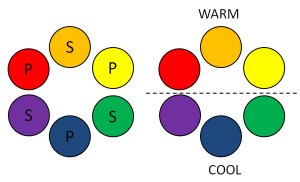
A simple colour wheel showing the distribution of primary (denoted by P) and secondary colours (denoted by S) (left) and which are classified as warm and cool colours (right).
Blue and purple are cool colours and are more commonly seen in temperate plants. The visual effects they produce are the opposite of warm colours. These colours give the viewer a serene or restful feeling and are ideal for creating a resting spot in the garden.
Due to the paucity of cool colours in tropical plants, cool colours can be incorporated into a garden by using hardscape elements like garden furniture or even artwork like sculptures. Putting a coat of paint of a cool colour on a hardscape element can change the look and feel of the landscape.
In the garden, neutral colours include green, white, black, grey, silver and brown. Neutral colours can be used with any other colour without changing the effect that one is trying to achieve. These colours can be used to tone down the other colours or serve as a bridge or buffer between two clashing colours.
Colour schemes
Depending on the plants that one likes, as well as, the theme garden, the following basic colour schemes can be considered. Instead of sporadically placing plants as they come into the landscape, designate pockets of space in your garden for different colour schemes. This can help to create different unique spaces for different plant groups and reduce clutter.
Monochromatic

Plants with relatively similar yellow foliage and flower colour give rise to this monochromatic landscape.
Combination of shades of a single colour leads to a monochromatic scheme. Such combinations are the easiest to put together, but may be challenging for a plant collector who has an interest in plants with varied colours. Thus this requires a great deal of discipline to get only plants that fit the colour scheme.
Analogous
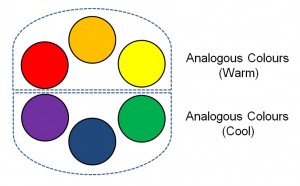
Analogous colour schemes involves colours that are next to each other on one side of the colour wheel. Shown here are two combinations can be done in groups of three colours such as red, orange, and yellow, and, green, blue and purple.
Analogous colours are those that are next to each other on one side of the colour wheel. Examples of analogous colour combinations are red and orange, orange and yellow, blue and violet, violet and red, etc. Combinations can also be done in threes such as red, orange, and yellow, etc. Such colour combinations tend to give rise to something that is visually harmonious.
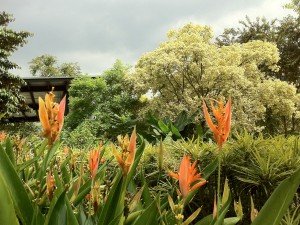
The orange inflorescences of the heliconia, the yellow leaves of Osmoxylon lineare and variegated Ficus rumphii form a landscape based on the analogous colour scheme.
Complementary
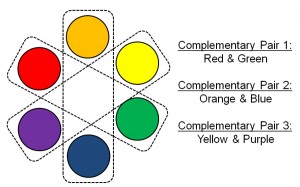
Complementary colour scheme refers to pairs of colours that are opposite each other on the colour wheel. Such combinations them are striking and can be used to create contrast.
Complementary colours are opposite each other on the colour wheel and combining them creates contrast and generates visual interest. Examples of complementary colour pairs are red and green, orange and blue, and violet and yellow.
Complementary colour combinations make colours stand up more when combined together than when used on their own. Avoid creating excessive contrast in the garden as overdoing it can be visually disturbing.
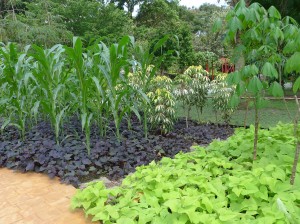
Colour contrast in a vegetable garden based on the complementary colour scheme is exemplified by purple and yellow coloured sweet potato plants. The yellow variegated cassava plants are made more obvious by planting them above the purple leafed sweet potato plant.
Triad
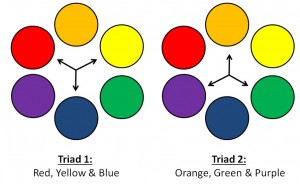
A colour triad consists of three colours located at each point of an equilateral triangle in the colour wheel. Shown here are two possible triads on a simple colour wheel.
A colour triad is created by drawing an equilateral triangle pointing to three colours in the colour wheel. For example, red, yellow and blue form a triad and another triad can be created by having violet, orange, and green together.
Once you have worked out the colour scheme for each section of your home or garden, you are ready to go and pick out the right plants and start decorating.
By Wilson Wong
Have views or comments on this article? Let us know via this form. If you would like to give us feedback on any other areas relating to our parks and gardens, please submit via https://www.nparks.gov.sg/feedback


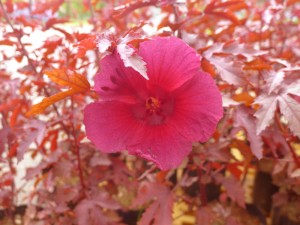
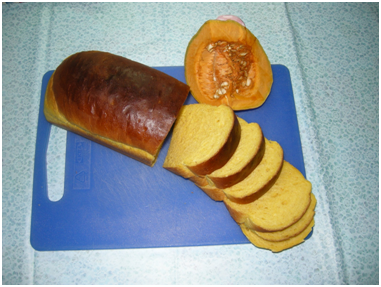
iraj 8/6/2013 1:05:00 PM